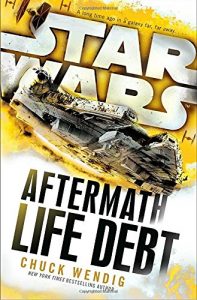 I find that Walking Dead graphic novels come out at the right pace. Twice a year, six issues each (which okay, that’s a pretty obvious rate if you pause to think about it), and whenever I get one in the mail it’s just about exactly the time that I think it’s been a little while since I read the last one. I wonder if I would itch for them more, if the show wasn’t also coming out on about that schedule (eight episodes instead of six, and closer to the turn of the year than an even split, but nonetheless) to fill in any extra itchings.
I find that Walking Dead graphic novels come out at the right pace. Twice a year, six issues each (which okay, that’s a pretty obvious rate if you pause to think about it), and whenever I get one in the mail it’s just about exactly the time that I think it’s been a little while since I read the last one. I wonder if I would itch for them more, if the show wasn’t also coming out on about that schedule (eight episodes instead of six, and closer to the turn of the year than an even split, but nonetheless) to fill in any extra itchings.
Sometimes I can tell what they were going for from the title, and other times (like now), not so much. I mean, Lines We Cross is a rich mine for the entire series, certainly, and most of the individual characters have a lot of story dedicated to that question. But this specific book? Nah, not seeing it.
That said, it is an introspective, quiet, rebuilding book, in which people have time to take stock of lines they have maybe already crossed, regrets they have, relationships lost and found. And I will never get tired of the parallel story arcs between two characters that would be very spoilery[1] to call out. But if introspection is not your thing, there’s a new hilarious character (right on the cover!) and the promise of a brand new storyline springing from the culmination of the radio conversations that built throughout the Whisperers arc. So, Kirkman’s definitely not out of ideas yet. And, at least for now, I’m not tired of hearing them yet.
[1] For a lot of reasons
 If you are looking for a book that explains why there’s wreckage all over Jakku in
If you are looking for a book that explains why there’s wreckage all over Jakku in  Thanks, random invite to a sneak preview from Alamo Drafthouse! The last one of these I got was for
Thanks, random invite to a sneak preview from Alamo Drafthouse! The last one of these I got was for  It took me until Monday night to see
It took me until Monday night to see  Did you know that they are still making Harry Potter movies? It’s true! But I got distracted and never actually saw
Did you know that they are still making Harry Potter movies? It’s true! But I got distracted and never actually saw  I liked this Deathlands book somewhat less than usual, for a variety of reasons, which I will now elucidate.
I liked this Deathlands book somewhat less than usual, for a variety of reasons, which I will now elucidate. I’m excited by the Olympics, because it apparently means nobody is airing any opposing television, which means I have time to watch movies! Hence
I’m excited by the Olympics, because it apparently means nobody is airing any opposing television, which means I have time to watch movies! Hence  When I was in LA in mid-December, I saw posters everywhere for a Netflix movie called
When I was in LA in mid-December, I saw posters everywhere for a Netflix movie called 
 There is one problem with publication order, and that problem is when small run publications are later gathered into collections. Well, to be fair, it’s not a problem with reading; you just read the part of the book that contains the story you were reading in publication order, and then put it down until later. But it is a problem for me specifically, since I include links to the book I read from, and yet
There is one problem with publication order, and that problem is when small run publications are later gathered into collections. Well, to be fair, it’s not a problem with reading; you just read the part of the book that contains the story you were reading in publication order, and then put it down until later. But it is a problem for me specifically, since I include links to the book I read from, and yet